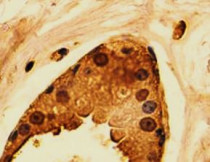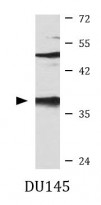ARG58455
anti-Torsin 1A antibody
anti-Torsin 1A antibody for IHC-Formalin-fixed paraffin-embedded sections,Western blot and Human,Mouse,Rat
Overview
| Product Description | Rabbit Polyclonal antibody recognizes Torsin 1A |
|---|---|
| Tested Reactivity | Hu, Ms, Rat |
| Tested Application | IHC-P, WB |
| Host | Rabbit |
| Clonality | Polyclonal |
| Isotype | IgG |
| Target Name | Torsin 1A |
| Antigen Species | Human |
| Immunogen | Recombinant fusion protein corresponding to aa. 63-332 of Human Torsin 1A (NP_000104.1). |
| Conjugation | Un-conjugated |
| Alternate Names | DQ2; Dystonia 1 protein; EC 3.6.4.-; Torsin-1A; DYT1; Torsin ATPase-1A; Torsin family 1 member A |
Application Instructions
| Application Suggestion |
|
||||||
|---|---|---|---|---|---|---|---|
| Application Note | * The dilutions indicate recommended starting dilutions and the optimal dilutions or concentrations should be determined by the scientist. | ||||||
| Positive Control | DU145 | ||||||
| Observed Size | 36 kDa |
Properties
| Form | Liquid |
|---|---|
| Purification | Affinity purified. |
| Buffer | PBS (pH 7.3), 0.02% Sodium azide and 50% Glycerol. |
| Preservative | 0.02% Sodium azide |
| Stabilizer | 50% Glycerol |
| Storage Instruction | For continuous use, store undiluted antibody at 2-8°C for up to a week. For long-term storage, aliquot and store at -20°C. Storage in frost free freezers is not recommended. Avoid repeated freeze/thaw cycles. Suggest spin the vial prior to opening. The antibody solution should be gently mixed before use. |
| Note | For laboratory research only, not for drug, diagnostic or other use. |
Bioinformation
| Database Links | |
|---|---|
| Gene Symbol | TOR1A |
| Gene Full Name | torsin family 1, member A (torsin A) |
| Background | The protein encoded by this gene is a member of the AAA family of adenosine triphosphatases (ATPases), is related to the Clp protease/heat shock family and is expressed prominently in the substantia nigra pars compacta. Mutations in this gene result in the autosomal dominant disorder, torsion dystonia 1. [provided by RefSeq, Jul 2008] |
| Function | Protein with chaperone functions important for the control of protein folding, processing, stability and localization as well as for the reduction of misfolded protein aggregates. Involved in the regulation of synaptic vesicle recycling, controls STON2 protein stability in collaboration with the COP9 signalosome complex (CSN). In the nucleus, may link the cytoskeleton with the nuclear envelope, this mechanism seems to be crucial for the control of nuclear polarity, cell movement and, specifically in neurons, nuclear envelope integrity. Participates in the cellular trafficking and may regulate the subcellular location of multipass membrane proteins such as the dopamine transporter SLC6A3, leading to the modulation of dopamine neurotransmission. In the endoplasmic reticulum, plays a role in the quality control of protein folding by increasing clearance of misfolded proteins such as SGCE variants or holding them in an intermediate state for proper refolding. May have a redundant function with TOR1B in non-neural tissues. [UniProt] |
| Cellular Localization | Endoplasmic reticulum lumen, Nucleus membrane, Peripheral membrane protein, Cell projection, growth cone, Cytoplasmic vesicle membrane, Cytoplasmic vesicle, secretory vesicle, synaptic vesicle, Cytoplasm, cytoskeleton. [UniProt] |
| Calculated MW | 38 kDa |
| PTM | N-glycosylated. [UniProt] |
Images (2) Click the Picture to Zoom In
-
ARG58455 anti-Torsin 1A antibody IHC-P image
Immunohistochemistry: Paraffin-embedded Human normal breast stained with ARG58455 anti-Torsin 1A antibody at 1:200 dilution.
-
ARG58455 anti-Torsin 1A antibody WB image
Western blot: 25 µg of DU145 cell lysate stained with ARG58455 anti-Torsin 1A antibody at 1:1000 dilution.







